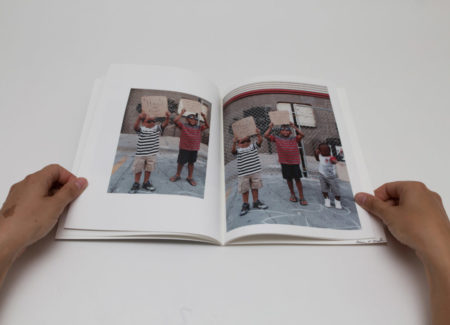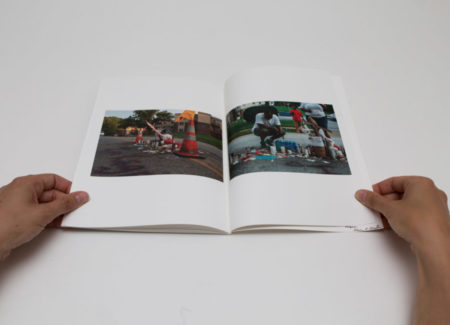JTF (just the facts): Self-published in 2015 (here). Softcover, 20 pages, with 40 color and black and white photographs. There are no texts or essays. (Cover and spread shots below.)
Comments/Context: In August of 2014, an eighteen-year-old African-American man, Michael Brown, was shot by a white police officer in Ferguson, Missouri. For a predominantly black city already suffering from years of racial mistrust, this incident reignited existing tensions, leading to a wave of civil protests. The events in Ferguson got significant attention in the United States and around the world, attracted protesters from other states, and started a strenuous debate about the fraught relationship between law enforcement and the African American community that continues today. Thousands of images started to stream out of Ferguson, many taken by local residents and shared on social media, providing a wide platform for reporting the unfolding events and expressing a collective mood of growing frustration.
Adrian Octavius Walker is a young photographer from Saint Louis, who happened to be in Ferguson as the events after the shooting started to unfold. Initially, there were few verifiable details, but eventually word of Brown’s death started to circulate and Walker spent the next few days photographing the aftermath and unrest. He also started sharing some of the photographs on social media, connecting with people and starting the discussion. A few months later, he decided to print a book that brought together images from Ferguson, a book that people could keep as a reminder of the events. He titled it My Lens, Our Ferguson.
An image of a cardboard sign with the words “Protect our future” serves as an introduction to the book, and sets the tone for the larger narrative. The next spread has two photographs: on the left there is an ordinary white man in a shirt with his hands up facing the armed police forces guarding the road; the image on the right depicts a different group of police blocking another road. Together, they create a feeling of being surrounded.
These are followed by images of diverse crowds of people on the streets (some of them children), marching and holding signs saying “Hands Up!! Don’t Shoot!!”, “No Justice, No Peace”, and “I am an American”. There are no pictures of violence, police crackdowns, or tear gas, but the frustration, anger, and anxiety of the community is palpable. Walker’s photographs reflect the authentic on-the-ground feelings of the moment, when the community’s hopes and fears were at their most vulnerable, and the city was trying to come together to heal.
Closer to the end of the book, there are images of the memorial for Michael Brown, with candles, flowers and toys gathered at the location of the shooting. Other images depict murals painted in his memory. The very last photograph is executed in shadowy black and white – in it, an African American young man holds a sign saying “Your silence is consent”. He looks straight back at us with a penetrating stare.
As a photobook, My Lens, Our Ferguson is a simple slim book, with one image on each page surrounded by ample white space. Most of the photographs are horizontal and are placed in the middle; the few vertical images take up more of the page, and add rhythm to the visual line. The title of the book and photographer’s name appear on the cover page, but this is the only text that accompanies the publication – there are no page numbers, no guiding captions or any text to provide context or interpretation. This is a strong and clever decision for this project, as it leaves the conclusions open ended.
My Lens, Our Ferguson can without a doubt be seen as a protest book. Its images are an immediate reaction to the unfolding events, and the book itself was published as downstream events were still developing. The title of the book references the recent historical moment in United States history, leaving no doubts about the book’s content, but it also defines the photographer’s modest, but active stand. As an African-American, Walker was deeply affected by the events and used his camera to document and share what was happening in the community, an action by and for the people.
The first copies of the photobook were sold through Walker’s Instagram account where he announced the publication with the following comment: “The books are priced at the costs to produce them. The only thing I want from the production of this book is for you to own a piece of history showing real life moments, emotion and truth”. My Lens, Our Ferguson stands as the artist’s first hand tribute to a community in mourning, and it is alive with the simmering energy and personal emotion of protest books from across the history of the medium.
Collector’s POV: Adrian Octavius Walker does not appear to have gallery representation at this time. Collectors interested in following up should likely connect directly with the artist via his website (linked above).













